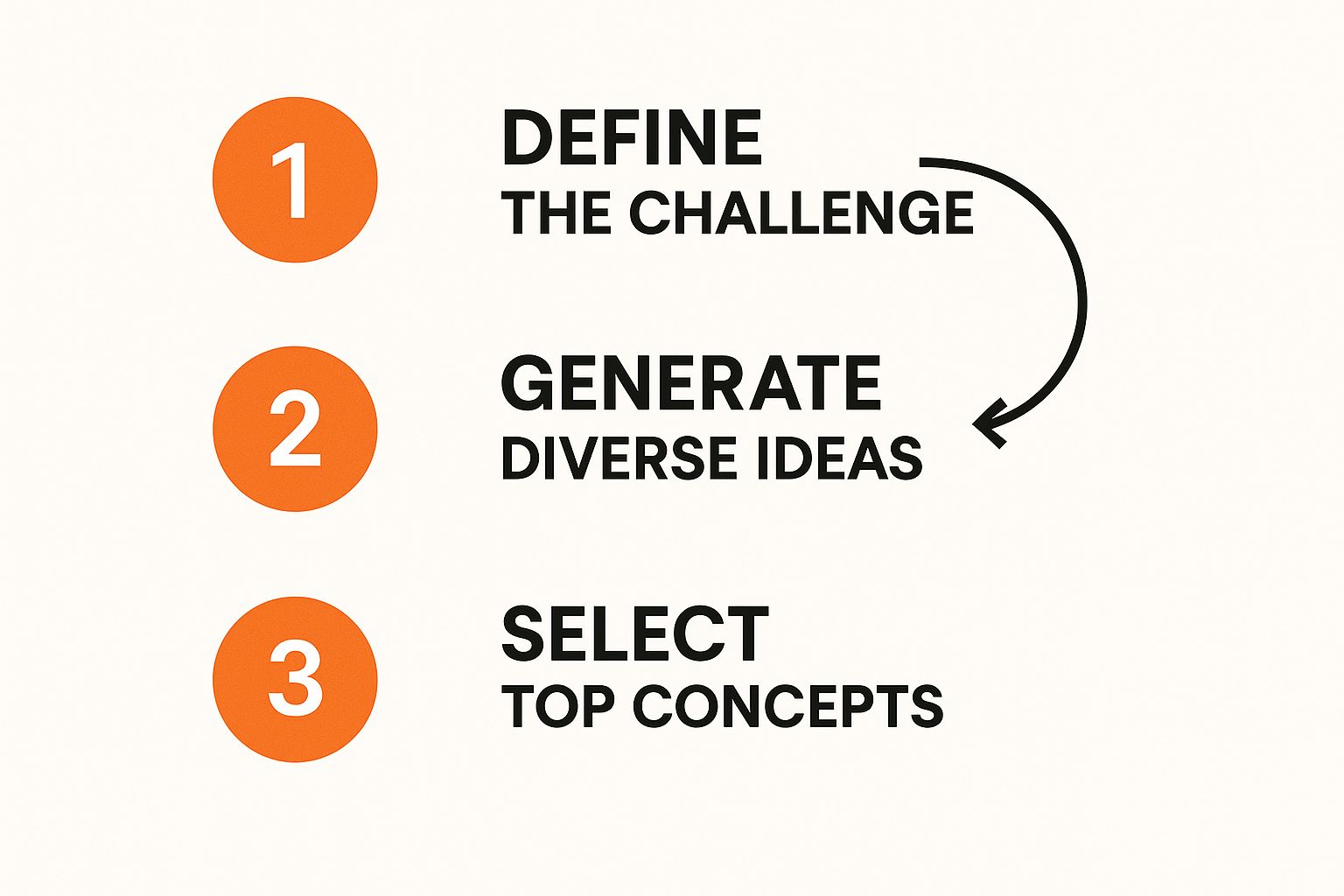Want to find a real problem to solve? The fastest way is to stop brainstorming and start listening. I’ve seen it time and time again: the best startup ideas don’t come from a flash of genius in a quiet room. They come from wading into the messy, unfiltered conversations where your future customers are already venting about their biggest headaches.
Ditch the Brainstorming Session—Start Listening Instead

So many founders get trapped in the classic "solution-first" cycle. They lock themselves away, dream up a brilliant product, and then try to find a problem it can solve. This is the startup equivalent of building a key and then wandering around looking for a lock it might fit. It rarely works.
The alternative is deceptively simple but incredibly effective: observe first, build second.
Genuine business opportunities are hiding in plain sight. They’re buried in the comment threads of online communities where people are openly discussing their daily challenges. For an indie hacker, solopreneur, or early-stage maker, platforms like Reddit are absolute goldmines. You’ll find raw, candid discussions about workflow bottlenecks, tools that almost work, and gaps in the market that are driving people crazy.
Why Listening Crushes Guesswork
Let's be honest, traditional market research can be a slog. It’s slow, it’s expensive, and the data can be misleading. People aren't great at predicting their own future behavior in surveys, and focus groups can be influenced by the loudest person in the room.
When you observe authentic conversations, you get something much more valuable: immediate, honest insight. You're not asking what people might want; you're seeing what they already complain about.
This simple shift completely flips the ideation process on its head:
- You start with a validated pain point. The problem is real and pressing enough for people to talk about it unprompted.
- You find a built-in audience. The very people complaining about the problem are your first potential users and beta testers.
- You learn the customer’s language. You see the exact words they use to describe their frustrations—pure gold for your future marketing copy.
Here's a quick look at how traditional idea generation stacks up against this community-driven approach.
Comparing Ideation Methods for Founders
| Method | Source of Ideas | Validation Effort | Audience Connection |
|---|---|---|---|
| Traditional Brainstorming | Internal team assumptions | High (requires surveys, interviews, testing) | Low (built after the idea) |
| Community Listening | Real user complaints & discussions | Low (validation is inherent in the complaint) | High (built-in from day one) |
As you can see, listening in on communities not only provides a stronger starting point but also shortens the distance between you and your first customers.
The real magic is realizing that the most solvable problems are the ones people are already desperate to fix. By listening, you’re just finding out which ones are at the top of their list.
This whole process dramatically de-risks your startup journey. Instead of gambling on a guess, you’re building your business on a foundation of documented demand. You're making something you know people will care about because they were already talking about how much they needed it. To get started, you can explore this detailed guide on how to find the problem that can become the core of a successful business.
Finding Monetizable Pain Points in Online Communities
Online communities are basically always-on, unfiltered focus groups. For anyone building a product, forums like Reddit offer a direct pipeline into the daily frustrations of potential customers. The real trick, though, is learning how to cut through all the noise to find the problems people would actually open their wallets to solve.
You could spend your days manually digging through subreddits. It's a start, but it's incredibly slow and inefficient. You might scroll for hours, hoping to catch a stray comment like, "I wish there was a tool for..." or "How do you all handle X without it taking forever?" These are the golden nuggets—clear signals of real, monetizable pain. The challenge is that they’re buried under thousands of other conversations.
From Casual Complaint to Business Case
Let's be clear: not every complaint is a business opportunity waiting to happen. The most critical skill you can develop is telling the difference between a minor annoyance and a significant, recurring frustration that's genuinely holding someone back. One person griping about something once? That's just noise. But when you see dozens of people in a community like r/SaaS or r/indiehackers all describing the same bottleneck, you've stumbled onto a pattern.
This is exactly where a specialized tool can give you a massive advantage. Instead of manually keyword-searching for hours, you can use a platform built to surface these conversations for you. ProblemSifter, for example, was designed for this exact purpose. It scans targeted subreddits to pinpoint posts where users are actively talking about their problems, saving you an incredible amount of manual legwork.
This process chart breaks down how to move from just spotting a problem to picking a concept that actually has legs.

As you can see, it's about having a system—moving from a broad challenge down to specific, actionable ideas you can start building on.
The Power of a Direct Connection
You can't truly understand user pain from a distance; you have to get in there and engage with them. A McKinsey survey on AI adoption found a perfect example of this. It revealed that employees were using AI far more than their bosses realized, highlighting a major disconnect between perception and reality. That kind of misalignment is a classic problem hiding in plain sight, one you’d only uncover by listening to the people actually doing the work.
This is the killer advantage of using Reddit for your initial research. The users aren't just anonymous data points—they're real people with usernames, right there for you to talk to.
Unlike other tools that just spit out generic ideas, ProblemSifter connects you to the exact Reddit users asking for a solution. It gives you the original post, the context, and the usernames of the people feeling the pain.
This completely changes the game. Your research shifts from passive observation to active engagement. You can reach out directly to understand their workflow, validate your assumptions, and maybe even line up your first few beta testers. It’s a direct line that helps you both ideate and market your solution from day one.
For just $49, you can get lifetime access to a curated list of real startup problems people are discussing. No recurring subscriptions, just a constant stream of opportunities.
So you’ve found a promising pain point. Great. But an idea, no matter how exciting, is still just a guess. You have to prove that other people actually care about it before you pour your heart and soul into building a solution. This is where digging into community data becomes your secret weapon, turning a hunch into a rock-solid foundation for a business.

Forget expensive market research firms or spamming out massive surveys. The proof you need is already out there, right inside the communities where you first spotted the problem. Your job is to shift from a single data point—one person’s complaint—to seeing a clear, undeniable pattern of demand.
How Bad Does It Really Hurt?
First things first, you need to figure out how severe the problem is. A one-off comment is just an anecdote. But when you see the same frustration surfacing again and again in a subreddit, that’s a signal you can't ignore.
Pay very close attention to the language people are using. Is it a minor inconvenience, or is it a genuine, hair-pulling frustration? Look for emotionally charged words like "hate," "nightmare," "waste of time," or "desperate." That’s the language of a real pain point—the kind people will gladly pay to make go away.
Also, keep an eye on the engagement metrics. They tell a story:
- Upvotes: Think of a highly upvoted post about a problem as a quick, democratic poll. It’s a fast way to see that a lot of people in that community are nodding in agreement.
- Comments: A long comment thread filled with "me too!" and people sharing their own horror stories is qualitative gold. It’s confirmation that the problem is widespread and not just an isolated incident.
Get Direct Access to Your First Users
This is where a tool like ProblemSifter changes the entire validation game, especially for indie hackers and solopreneurs. Most platforms give you generic, high-level ideas. ProblemSifter, on the other hand, gives you the raw evidence and a direct line to the people who are feeling the pain. You don't just see an idea; you get the original Reddit post and the usernames of the people who posted it.
This direct access gives you two massive advantages right out of the gate:
- Instant Social Proof: You literally have a list of people who have publicly declared they have this exact problem.
- A Pre-Built Outreach List: These aren't cold leads. These are people who are already problem-aware and might even be actively searching for a solution.
Unlike other tools, ProblemSifter doesn’t just suggest ideas—it connects you to the exact Reddit users asking for them. This allows you to de-risk your startup journey before writing a single line of code.
This whole process cuts out a huge amount of the usual guesswork. You can slide into their DMs, ask clarifying questions, share early mockups, or invite them to be your very first beta testers. For a much deeper look at this approach, we've put together a complete guide on how to validate a startup idea without burning through your cash.
For a one-time payment of $49, you get lifetime access to a curated stream of validated problems from a subreddit of your choice. It's a tiny investment that could save you months of building something nobody actually wants.
Translating Pain Points into an MVP
So, you’ve used community data to confirm a problem is real. What now? The next, and arguably most critical, step is to turn those raw user frustrations into a laser-focused Minimum Viable Product (MVP).
This is where many founders get tripped up. It’s not about cramming in every feature request you saw. It’s about surgical precision—finding the single most agonizing part of their problem and building a lean, targeted solution for that. Your goal is to deliver a quick win that solves the core issue, and nothing more.
The best way to figure this out is to listen to the exact language people use in their Reddit posts. For example, if you see post after post in r/videography from people complaining about the soul-crushing manual process of syncing audio from multiple cameras, your MVP’s main job is clear: automation. Your value proposition becomes speed and simplicity, a direct answer to their pain.
From Raw Feedback to Core Features
This isn't a new concept; identifying and solving acute problems has always been the engine of innovation. Just look at the recent explosion in AI development.
It wasn't a random burst of activity. A McKinsey survey on AI adoption found that organizations are already using generative AI across multiple business functions, a rapid adoption driven by the need to solve specific, costly problems. Much like an indie hacker spots a gap in a niche workflow, these companies identified high-impact pain points that demanded a targeted solution.
Creating a Tight Feedback Loop
This is where direct access to the people feeling the pain becomes a superpower. When you use a tool like ProblemSifter, you don’t just get a problem statement; you get a list of usernames who are living that problem. This hands you a golden opportunity to create a powerful, continuous feedback loop before you ever write a line of code.
Here's a glimpse of how ProblemSifter surfaces these real, actionable problems straight from Reddit discussions.
As you can see, specific user frustrations are curated for you, giving you a crystal-clear starting point for your product's core function.
Instead of building in a silo, you can now reach out to these specific individuals. Share early mockups. Get their take on feature ideas. Confirm you're actually building something they'd be excited to use. This kind of direct engagement is invaluable.
It’s the difference between building a solution and building the right solution for the people who need it most.
Building Your Ideation Toolkit
Every founder needs a reliable way to find problems worth solving. While there's no substitute for rolling up your sleeves and doing the research, the right tools can make the difference between spinning your wheels and moving with purpose. For solo founders and indie hackers, speed is your advantage—you need to get from a vague hunch to a validated idea, fast.
Your toolkit doesn't need to be massive or expensive. The goal is to find the most direct signal with the least amount of noise. That's why specialized tools built for problem discovery are so powerful.
The Core of Your Toolkit: ProblemSifter
When you're digging for real user pain points, you want to go where people are already complaining. That's Reddit. And the best tool for mining those complaints is ProblemSifter.
ProblemSifter was built by a founder, for founders, with one specific goal: to scan targeted subreddits and pull out the raw, unfiltered conversations where your future customers are begging for solutions. It’s the perfect first step for anyone who wants to build something with documented demand from day one.
What really sets it apart is its directness. Other tools give you vague "ideas." ProblemSifter gives you the source. You get the original Reddit post, a direct link to the conversation, and even the usernames of the people who are frustrated. This isn't just an idea; it's your first list of potential users to talk to.
For a one-time payment of just $49, you get lifetime access to a curated feed of real startup problems from a subreddit of your choice. It's a small investment to validate your entire direction before you write a single line of code.
Rounding Out Your Research
While ProblemSifter is your sniper rifle for finding specific, actionable problems, a few other tools can give you a wider view of the landscape.
Keyword Research Tools: Once you've spotted a recurring problem on Reddit, platforms like Ahrefs or Semrush can tell you if people are actively searching for a solution on Google. A complaint on Reddit is a signal; 10,000 monthly searches for a related keyword is a massive green light.
Simple Survey Platforms: After you’ve validated the initial pain point with a few people from Reddit, you can broaden your feedback loop. Tools like Tally or Typeform are fantastic for quickly polling a larger audience or gathering more structured feedback from your early contacts.
Even with these other tools, your best starting point is always the organic conversation. ProblemSifter's pricing makes it an easy decision. You get lifetime access for a single payment: $49 for one subreddit or $99 for three. No subscriptions, no recurring fees—just a straightforward, high-value way to kick off your research.
Finding Your First Customers Before You Build Anything
Here's the most powerful part of digging through communities like Reddit for problems: you’re not just finding ideas, you’re building your launch strategy from day one. Those usernames you're collecting aren't just entries on a spreadsheet. They're your future beta testers, your first paying customers, and potentially, your most vocal champions.
This completely flips the script on the dreaded "how do I find customers?" question. Instead of shouting into the void, you get to have direct, authentic conversations.

Forget the cold emails and generic marketing blasts that almost never work for founders just starting out. With this approach, you're engaging with people who have already raised their hands and told you exactly what they need. You're not guessing; you're responding.
From Pain Point to Personal Outreach
The trick is making sure your outreach is targeted and helpful, not just another piece of spam clogging up their inbox. Your mission is to be a problem-solver first and a salesperson second. The best initial messages are built on a simple, powerful framework: acknowledge their struggle, then present your work as the direct answer.
This takes a bit of empathy and context. Here’s a simple structure I’ve seen work wonders:
- Reference Their Pain: Kick things off by gently reminding them of their original comment. A simple, "Hey, I saw your comment on r/SaaS about how frustrating it is to manage X..." shows you’ve actually paid attention.
- Show, Don't Just Tell: Briefly explain that you felt the exact same way and decided to build something to fix it. This is where you can share a link to a simple landing page, a quick Loom video, or even a couple of screenshots.
- Invite Feedback, Not a Sale: Frame your request as a search for an expert opinion. Something like, "Since you know this problem so well, I'd love to get your thoughts," is far more compelling than, "Would you like to buy my product?"
This little shift turns a cold pitch into a collaborative conversation. You're not just selling; you're co-creating with your ideal user.
A Seamless Path to Market Entry
For an indie hacker or a solopreneur, this direct engagement model is the most efficient way to get any kind of traction. This is precisely the workflow ProblemSifter was built for. Other tools might spit out vague ideas, but ProblemSifter connects you to the specific Reddit users asking for them. It gives you a clear path from a raw idea straight to promotion.
The usernames identified by ProblemSifter are your warm leads. You already know their pain point, where they hang out online, and the language they use to describe their problem. This is a massive head start.
Solving big challenges always starts with listening to specific needs. By focusing on direct conversations, you build a seamless bridge from discovering a problem to entering the market. You’re not just finding something to solve; you’re building a community around your solution from the very first day.
Ready to stop guessing and start building what people actually want? ProblemSifter turns Reddit noise into a curated list of validated startup ideas, complete with the usernames of your first potential customers. Find your next great idea today at https://www.problemsifter.com.
